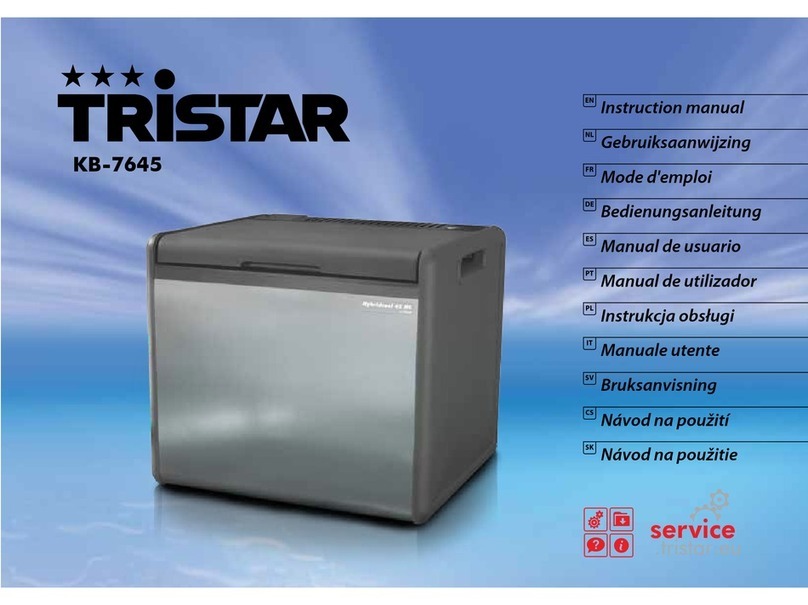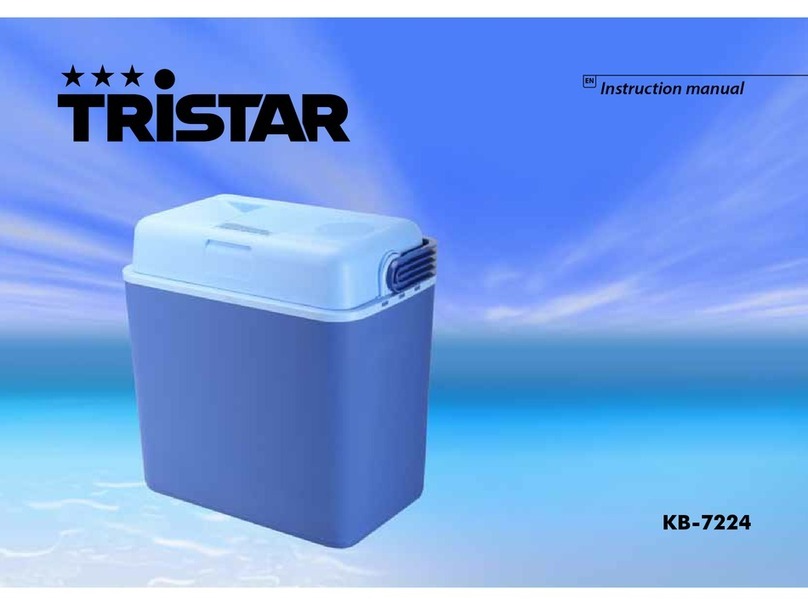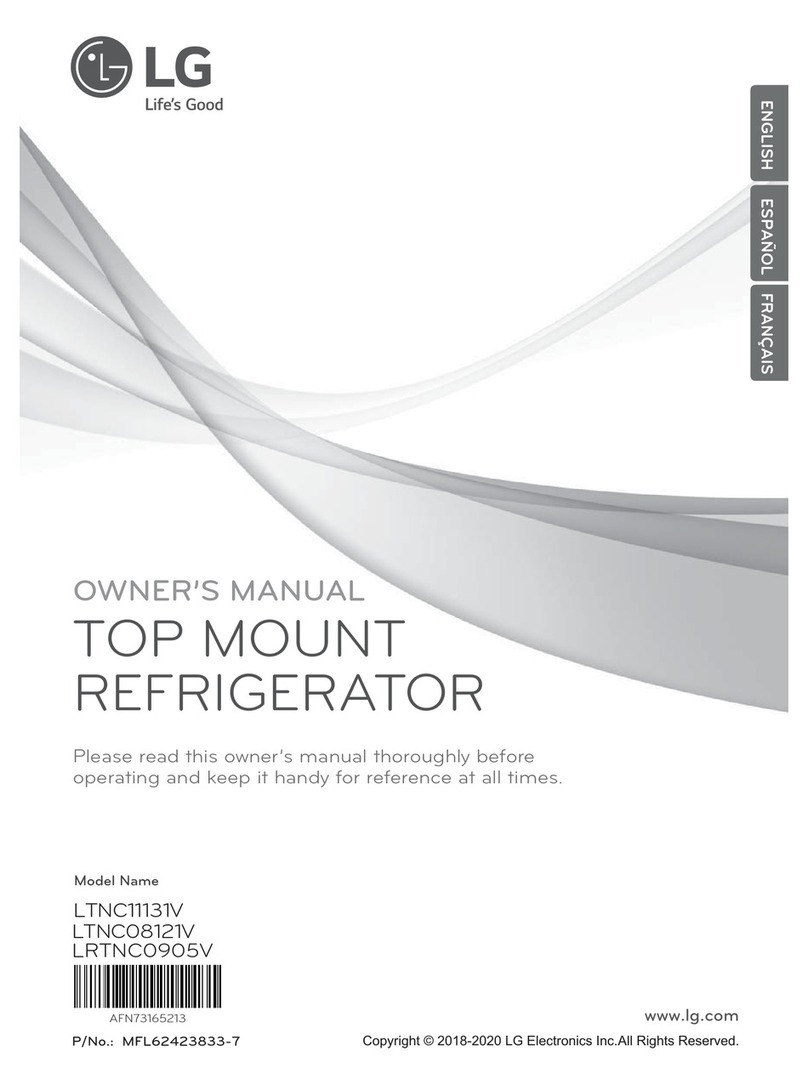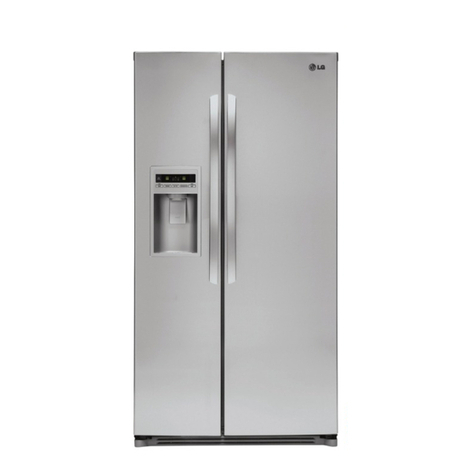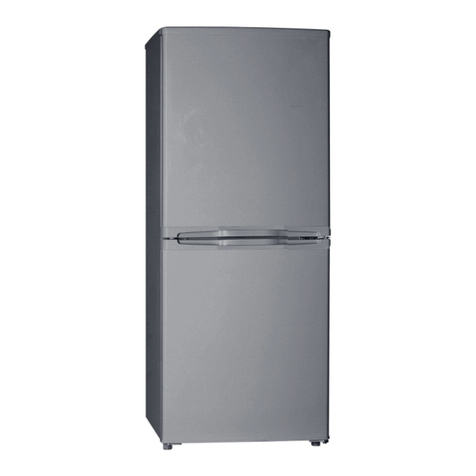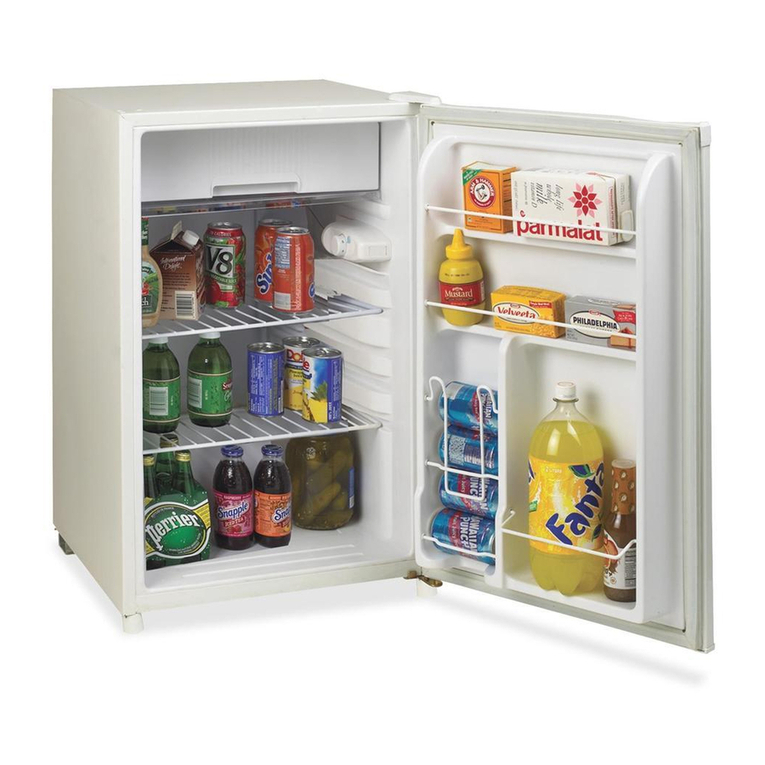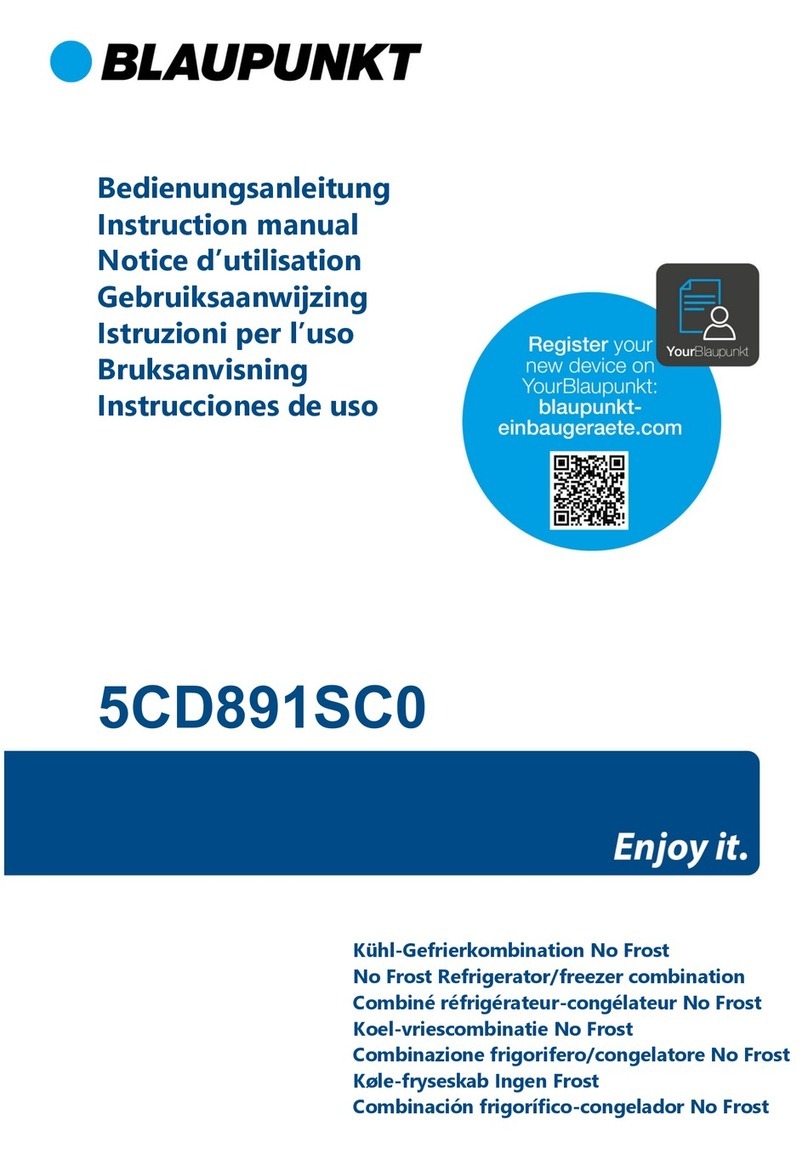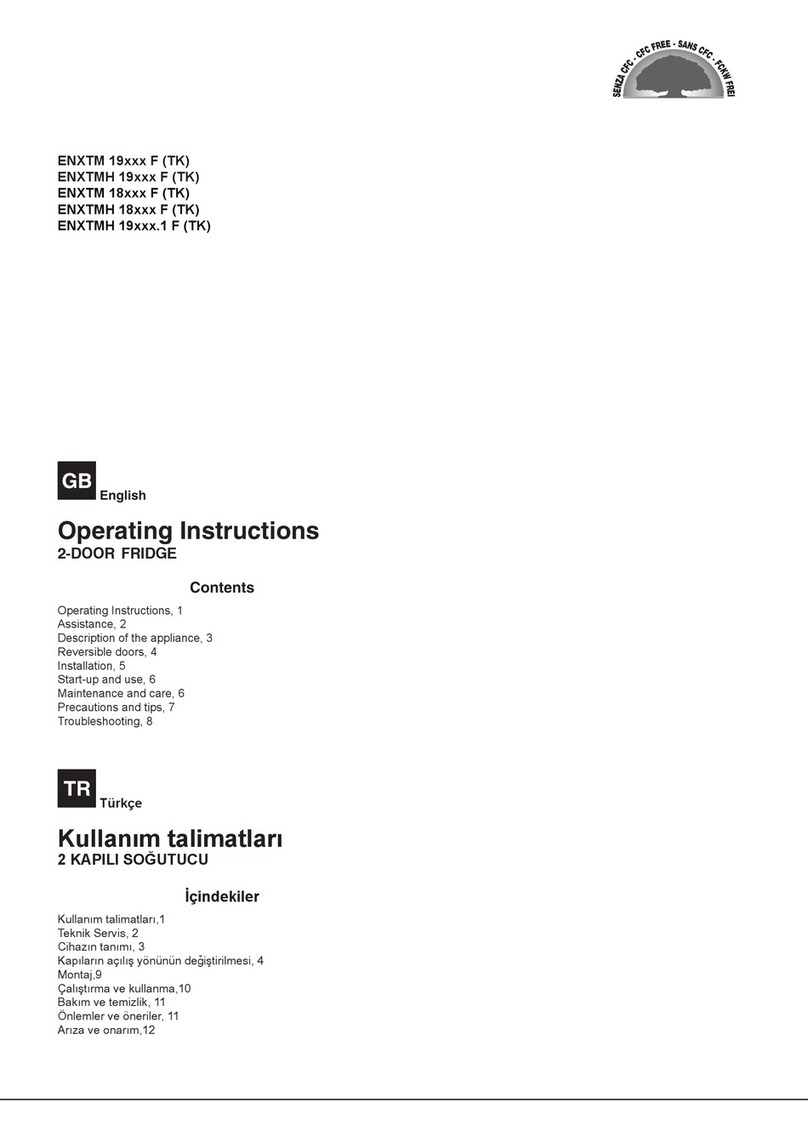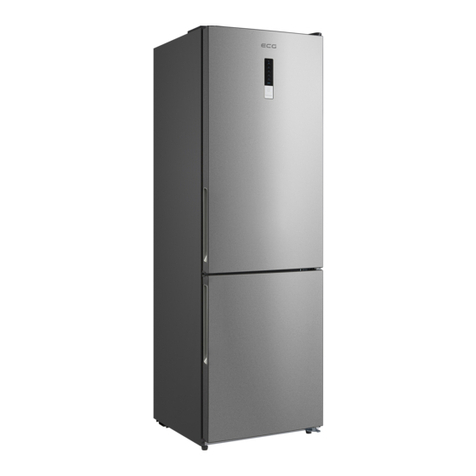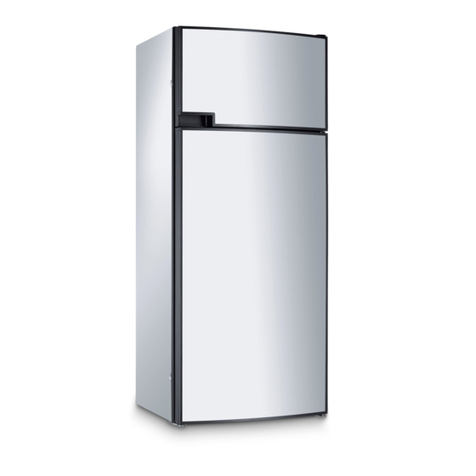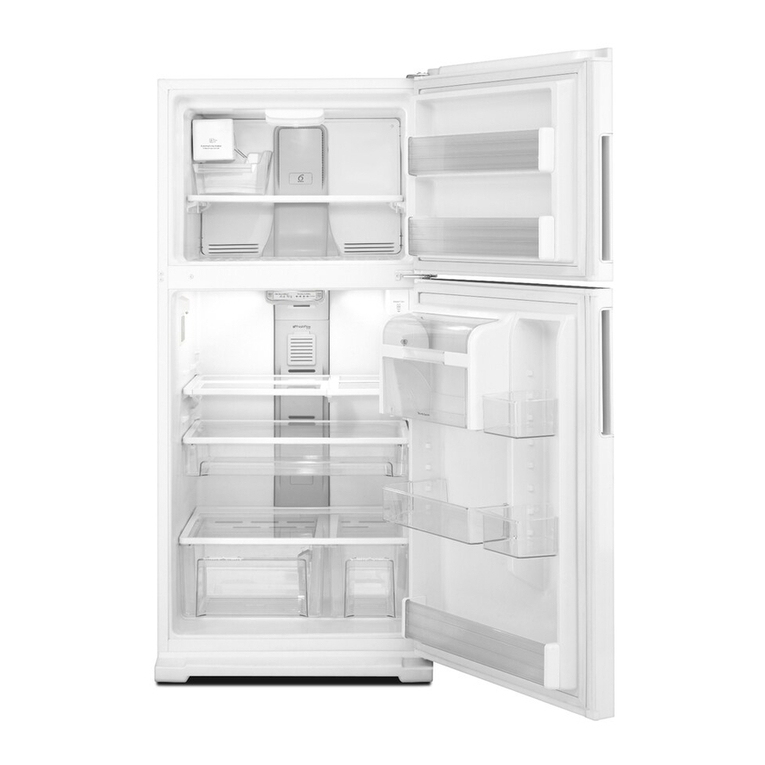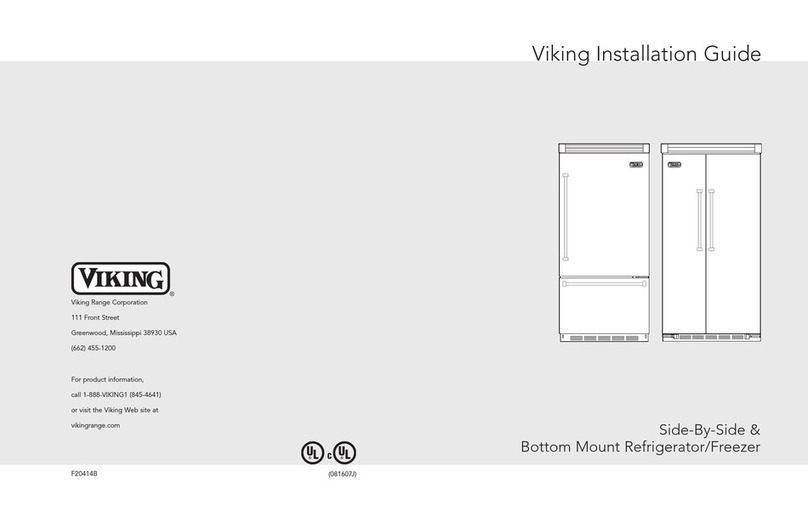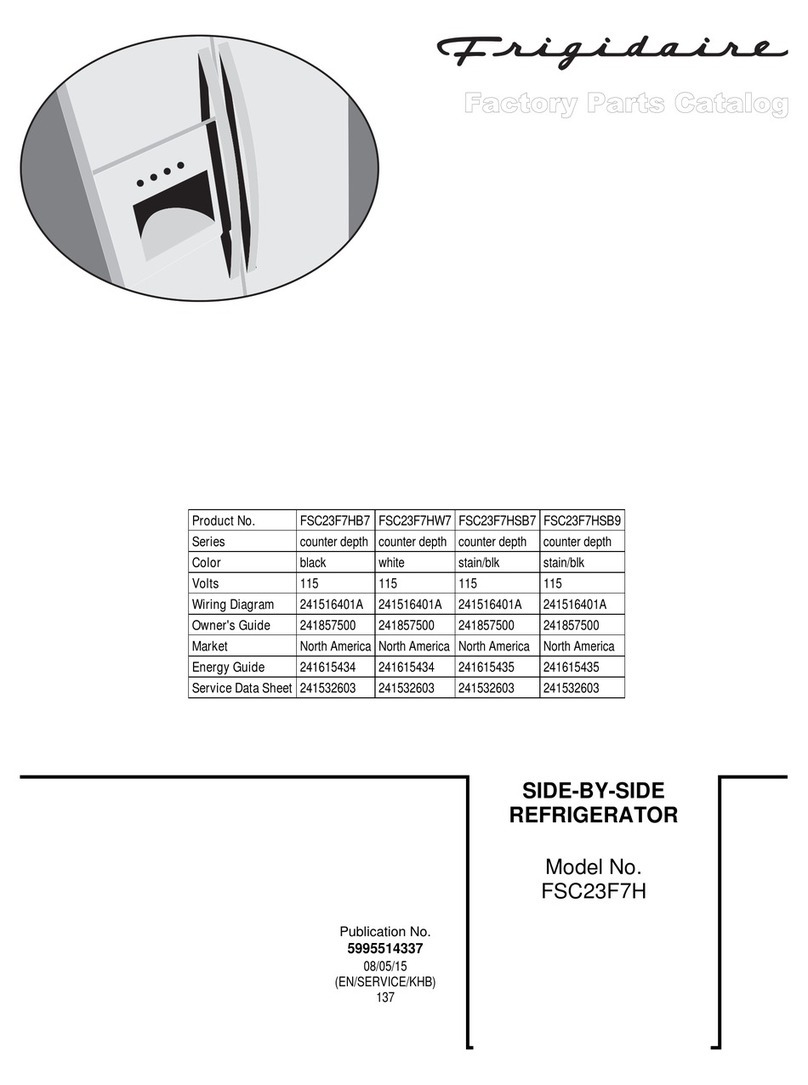TriStar KB-7060UK User manual

Tristar Europe – Emma Goldmanweg 10 – 5032MN – TILBURG - NETHERLANDS
KB-7060UK
1
*****
ABSORPTION FRIDGE KB-7060
INSTALLATION, OPERATION, MAINTENANCE INSTRUCTIONS
DC Connector AC Connector Thermostat Knob Gas Regular Knob Gas Meter

2
IMPORTANT
Read the operating instructions carefully in order to get to know the
equipment before putting it into operation.
Keep the instructions for future reference.
The absorption fridge is designed for built-in application.
Installation of the appliance
Appliance dimensions (H X W X D): 630mm X 490mm X 485mm
Built-in dimensions (H X W X D): 680mm X 590mm X 545mm
CAUTION: Do not operate by liquefied petroleum gas if there are no
ventilation openings.
The area of ventilation opening must not be less than 20% of the appliance
back cross-sectional area.
The appliance must be installed in an enclosure, the bottom of which must
Ventilation opening
3
be horizontal and even so that the appliance can be easily pushed into
place. It must be sturdy enough to carry the weight of the appliance.
There must be 100mm free space at least behind the appliance, and keep
more
than 50mm of clearance between the appliance and enclosure on other
sides.
The appliance must keep away from tinder and any source of heat.
To be used only in a well-ventilated area, above ground and protected from
rain.
To guarantee a good level of air circulation, do not obstruct the ventilation
grids of the upper, lower or rear surface of the appliance.
Complying with the above will ensure efficient an economical cooling.
Before the first use of the appliance, clean the inside and the cover of the
appliance with warm water, adding detergent if necessary. Never use an
abrasive product.

4
Screw
Installation of the flue kit
The flue kit is as an accessory. To iInstall the flue kit on the cooling unit and
use a screw to firmly fix it according to the needs of use.
Operation with the mains
Never use another source of energy at the same time (battery, liquefied
petroleum gas).
Check that the mains voltage corresponds to the operating voltage
specified on the label.
If the electrical specifications are correct, push the safety electrical plug
into an earthed wall socket which is wired according to the spectifications.
If the supply cord is damaged, it must be replaced by the supply cord with
identical technical data of the original supply cord.
The plug should be accessible after the appliance installed.
Start-up
Turn the thermostat knob clockwise to the MAX position. The effects of the
cooling process (frost on the evaporator) only become visible after about
an hour.
The thermostat enables the temperature of the refrigerator to be adjustable
(“0”=cooling process stopped).
After a sufficient cooling period (approximately 5 hours), the thermostat can
be set to an intermediate position. The selected temperature is regulated
automatically by the thermostat.
Shut-down
Turn the AC or DC switch off.
Remove the plug from the wall outlet.
F
lue kit
Cooling unit
5
Operation with a battery
Do not use another source of energy at the same time (mains, liquefied
petholeum gas).
A safety fuse must be installed in the power supply line between the battery
and the refrigerator.
The cable between the battery and the appliance must be protected by a
fuse with a maximum rating of 6.25 amps.
Select a cross section for the cable between the battery and the socket of
the 12V power supply according to the following table:
Max. cable length
Cable cross
-
section
12V DC
2.5mm
2
2.5m
4.0mm
2
4.0m
6.0mm
2
6.0m
It is not necessary to check the polarity when starting up the appliance.
Check that the battery voltage corresponds to the operating voltage of the
refrigerator, as marked on the corresponding the label. When the battery
used is a car battery, only switch the refrigerator on while the car is
traveling. If the refrigerator is left running when the car is stopped, this
could discharge the battery and it may be impossible to restart the engine.
When the appliance is running on the battery, there is no
thermostat-controlled temperature regulation.
Operation with liquefied petroleum gas
Operation of the refrigerator on liquefied petroleum gas is prohibited in the
open air.
Do not use another source of energy at the same time (mains, battery). The
label at the rear of the appliance gives the recommended gas supply
pressure expressed in milibars.
The appliance can not operate at a pressure other than the one specified
on the label. It is recommended to use an appropriate pressure regulator
(butane 28-30 mbar or 50mba, propane 37 mbar).
Storage of gas cylinders
Store the gas cylinder in a cool, dry and ventilated area, protected from
sunlight and do not exposed to temperatures above 50 degrees.

6
Connection of the refrigerator to the cylinder of liquefied petroleum
gas
CAUTION: always stay clear of any source ignition during this operation.
Do not smoke.
Connect the COOLBOX in the following order:
Gas cylinder > pressure regulator > appliance
Precautions shall be taken to comply with national regulations relating to
the operation of gas appliances whilst the vehicle is in motion.
The gas connection tube at the rear of the appliance is designed for a
standard NF XPD 36 110 tutane / propane flexible hose. It is essential to
follow the assembly and connection instructions for the aplliance to be
connected. Excessive twisting and bending are to be avoided. Bends in the
gas hose must have a radius of more than 40 mm. The length of the hose
must not exceed 1.5m.
If you wish to check for leaks, please use soapy water, do not use a flame.
It is prohibited to checke for leaks with a flame.
Do not smoke: danger of explosion and burns.
7
When changing the gas cylinder and/or disconnecting the hose, it is
mandatory to close the valve of the gas cylinder.
Replace the hose if it is damaged or if it becomes porous and in any case
before the expiry date printed on the side
Gas valve assembly
This assembly consists of an adjusting device with an incorporated safety
pilot, a burner with an electric igniter.
The adjusting device can be set to 3 different positions:
M
ax
Maximum cooling
MIN
Minimum cooling
0 off
Igniting position / burner gas supply
closed
The safety pilot automatically maintains the gas supply to the burner as
long as it remains lit. It automatically shuts off the supply if the flame goes
out.
Ignition of the liquefied petroleum gas burner.
Turn on the valve of the gas cylinder.
Press the adjusting knob and hold it in this position, then turn the knob the
anti-clockwise to Max. The burner starts to work, and the gas meter points
to the red area. If the appliance has not been ignited for a long period, or if
the gas cylinder has been changed, there may be some air in the duct, so it
may fail to be ignited. It is necessary to check that the pilot is lit by looking
through the orifice at the top of the appliance. If the appliance fails to be
ignited, try it again after approximate 10 seconds.
When the outside temperature is low, set the adjusting devise to MIN after
a sufficient long cool-down period in MAX position.
To disconnect an appliance running on gas Far from any source of
ignition
Shut off the gas cylinder or the pressure regulator.
Turn the knob to the OFF position.
Storing food
Liquids to be stored in the refrigerator shall always be placed in a closed
vessel.
The air circulation inside the appliance must not be obstructed.

8
Never place hot food or drink in the appliance.
Never keep flammable liquids and/or gases inside the refrigerator. Danger
of explosion.
Defrosting——Measures to be taken if the appliance is to be left
unused for a long period.
The refrigerator must be defrosted regularly, in order to ensure that it
operates correctly.
To defrost the refrigerator, disconnect it and remove all food outside. If
necessary, use a cloth soaked with hot water. After de-icing, mop up the
water with a dry clean cloth and clean the inside as described in paragraph
13.
If the appliance is to remain unused for a extensive period, disconnect it
and remove all food outside. After de-icing, clean and dry the inside of the
appliance.
In order to prevent unpleasant odor, leave the cover of the refrigerator
slightly open.
Measures to be taken after unused for a long period
If, after an extensive lay-up period, the refrigerator does not produce
any cooling, disconnect the appliance and turn it upside down for a few
minutes then turn it the right way up. After turn it over several times,
reconnect it.
Maintenance
Clean the appliance regularly with warm water, containing a detergent if
necessary. Never use an abrasive product. Dry the cleaned surfaces with a
soft cloth. Use only clear water to clean the seal of the cover, and then coat
the seal with talcum powder.
All repairs, particularly of the cooling unit or the gas burner system, must
mandatorily be carried out by a qualified technician.
9
Service
If a problem occurs, carry out the following checks:
- Is the appliance installed in a horizontal position?
- Is there sufficient ventilation?
- For 220V mains operation, check that the mains supply is correct. And is
the thermostat set correctly?
- For battery operation, check the battery and the connection.
- For gas operation, is the burner ignited?
- Has the ignition safety (adjustment) knob been set to MAX?
- Are the gas cylinder valve and/or the pressure regulator open?
- Is there still a sufficient quantity of gas in the cylinder? The cylinder is
empty if no
liquid can be heard moving about when it is shaken.
- Have two modes of energy (gas and electricity) been selected at the
same time?
- Has too much food been placed inside the refrigerator all at once?
Arrange the food so that the air is free to circulate inside the refrigerator.
Do not use pieces cardboard or plastic as separations. Keep vessels
containing liquids closed.
If, despite the above checks, you still need to contact the service
department, describe the failure and state the type of equipment and its
serial number (these are marked on the lebel).
If the power cable is damaged, it must be maintained by the original
factory/ after-service center or qualified person to avoid harmful
substances.

10
Technical specifications
Model
KB
-
7060
Gro
ss volume
60
L
Climate classification
S
N,
N
Insulation class
I
Refrigerant
NH
3
(80g), H
2
O, He
Foam
v
esicant
C
-
Pentane
Net weight
23
.5kg
Mains voltage
AC220
-
240V 50HZ
Rated power
82W
Consumption of energy
1.2
k
Wh/24h
Bettery voltage
DC12V
Rated pow
er
75
W
Consumption of energy
1
7
0Ah/24hrs
24hrs
Gas classification
I
3
+
I
3 B/P(30)
I
3 B
/P(
5
0)
Heat input (Hs) (W)
180W
180W
200W
140W
140W
140W
Gas pressure
28
-
3
0
/37
mbar
30mbar
50mbar
Gas consumption (Max)
12.8g/h
Gas consumption (Min)
8.3g/h
For the disabled person and children
This appliance is not intended for use by persons (including children) with
reduced physical, sensory or mental capabilities, or lack of experience and
knowledge, unless they have been given supervision or instruction
concerning use of the appliance by a person responsible for their safety.
Children should be supervised to ensure that they do not play with the
appliance.
Guidelines for protection of the environment
This appliance should not be put into the domestic garbage at the end of its
useful life, but must be disposed of at a central point for recycling of electric
and electronic domestic appliances. This symbol on appliances’ instruction
manual and packaging puts your attention to this important issue. The
materials used in this appliance can be recycled. By recycling used domestic
appliances you contribute an important push to the protection of our
environment. Ask your local authorities for information regarding the point of recollection.
This manual suits for next models
1
Other TriStar Refrigerator manuals
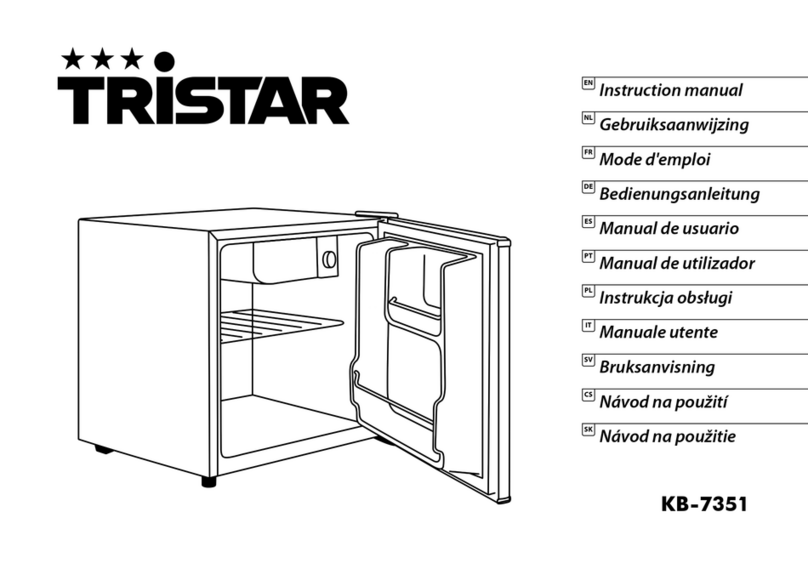
TriStar
TriStar KB-7351 User manual
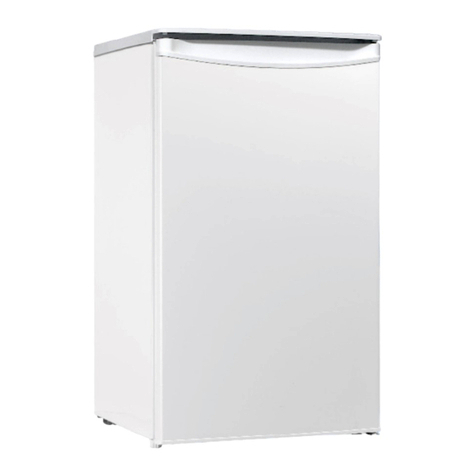
TriStar
TriStar KB-7390 User manual

TriStar
TriStar KB-7351 User manual
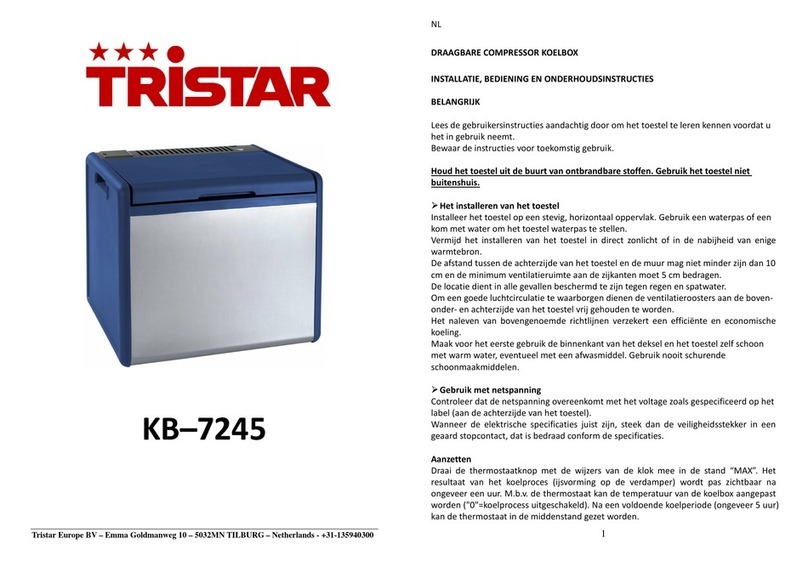
TriStar
TriStar KB-7245 Manual
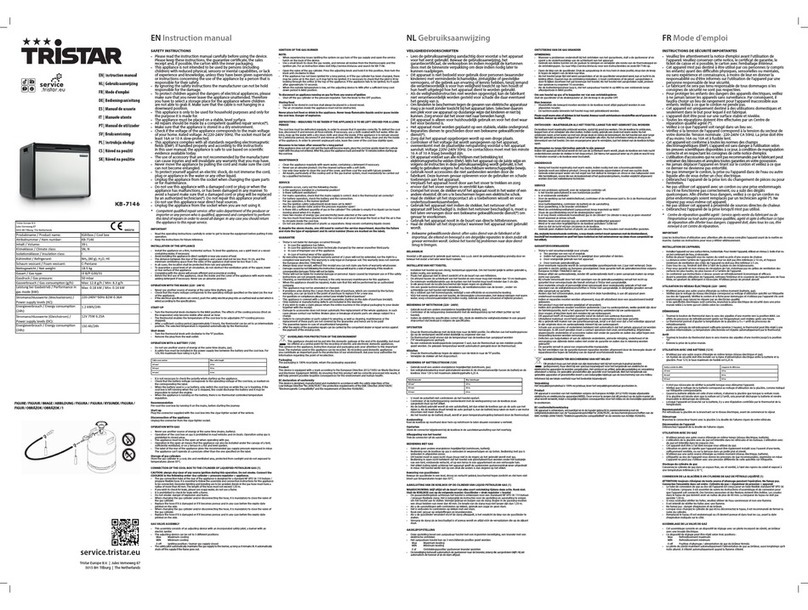
TriStar
TriStar KB-7146 User manual
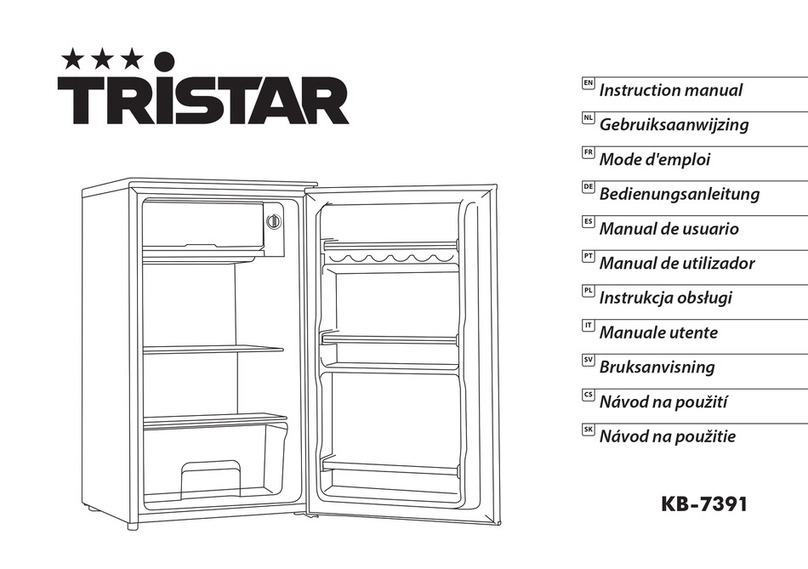
TriStar
TriStar KB-7391 User manual
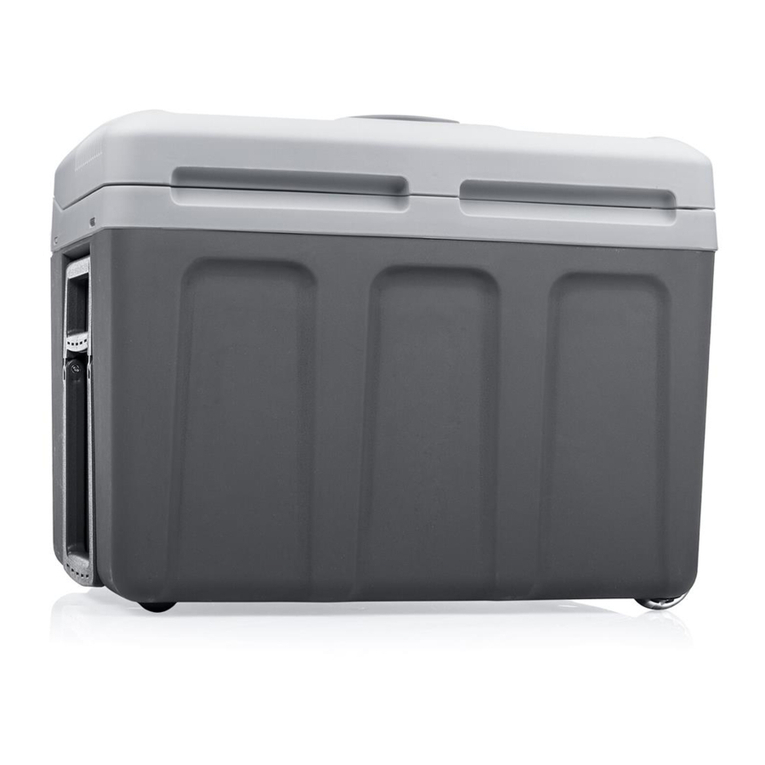
TriStar
TriStar KB-7540 User manual

TriStar
TriStar KB-7645 User manual
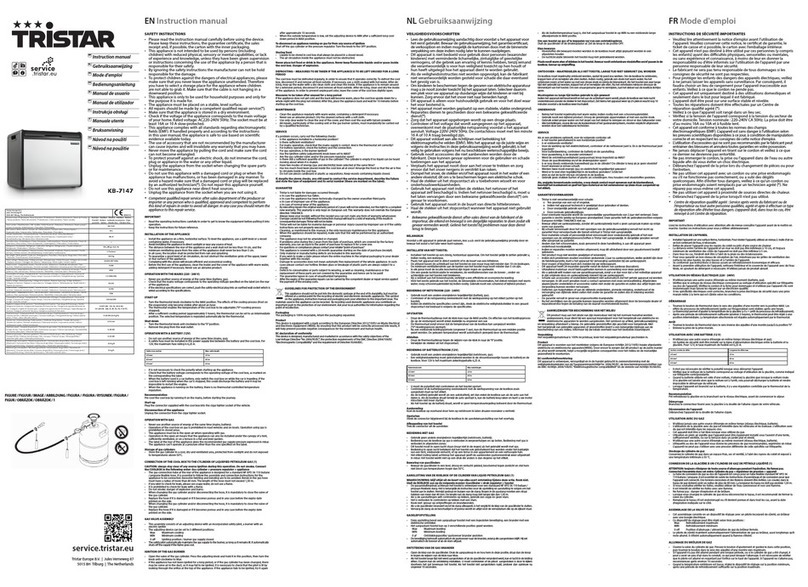
TriStar
TriStar KB-7147 User manual

TriStar
TriStar KB-7147 User manual
